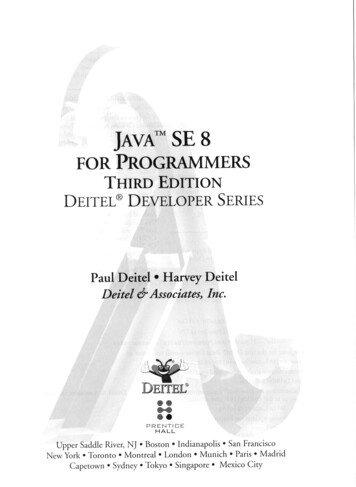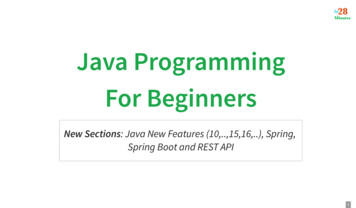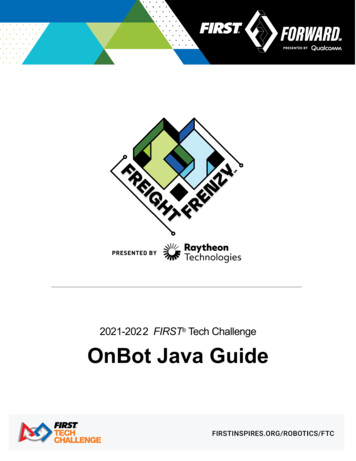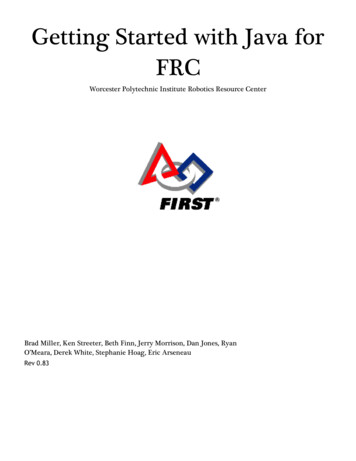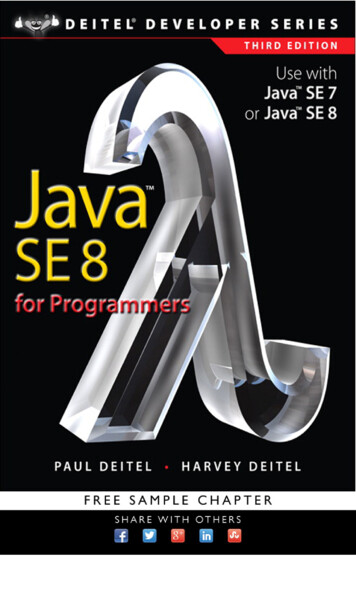
Transcription
JAVA SE 8FOR PROGRAMMERSTHIRD EDITIONDEITEL DEVELOPER SERIES
Many of the designations used by manufacturers and sellers to distinguish their products are claimed as trademarks.Where those designations appear in this book, and the publisher was aware of a trademark claim, the designations havebeen printed with initial capital letters or in all capitals.The authors and publisher have taken care in the preparation of this book, but make no expressed or implied warrantyof any kind and assume no responsibility for errors or omissions. No liability is assumed for incidental or consequentialdamages in connection with or arising out of the use of the information or programs contained herein.For information about buying this title in bulk quantities, or for special sales opportunities (which may include electronic versions; custom cover designs; and content particular to your business, training goals, marketing focus, orbranding interests), please contact our corporate sales department at corpsales@pearsoned.com or (800) 382-3419.For government sales inquiries, please contact governmentsales@pearsoned.com.For questions about sales outside the U.S., please contact international@pearsoned.com.Visit us on the web: informit.com/phLibrary of Congress Cataloging-in-Publication DataOn file 2014 Pearson Education, Inc.Portions of the cover are modifications based on work created and shared by Google (http://code.google.com/policies.html) and used according to terms described in the Creative Commons 3.0 Attribution License (http://creativecommons.org/licenses/by/3.0/).All rights reserved. Printed in the United States of America. This publication is protected by copyright, and permissionmust be obtained from the publisher prior to any prohibited reproduction, storage in a retrieval system, or transmission in any form or by any means, electronic, mechanical, photocopying, recording, or likewise. To obtain permissionto use material from this work, please submit a written request to Pearson Education, Inc., Permissions Department,One Lake Street, Upper Saddle River, New Jersey 07458, or you may fax your request to (201) 236-3290.ISBN-13: 978-0-13389138-6ISBN-10: 0-13-389138-0Text printed in the United States at Edwards Brothers Malloy in Ann Arbor, Michigan.First printing, March 2014
JAVA SE 8FOR PROGRAMMERSTHIRD EDITIONDEITEL DEVELOPER SERIESPaul Deitel Harvey DeitelDeitel & Associates, Inc.Upper Saddle River, NJ Boston Indianapolis San FranciscoNew York Toronto Montreal London Munich Paris MadridCapetown Sydney Tokyo Singapore Mexico City
Deitel Series PageDeitel Developer SeriesAndroid for Programmers: An App-DrivenApproach, 2/E, Volume 1C for Programmers with an Introduction to C11C 11 for ProgrammersC# 2012 for ProgrammersDive Into iOS 6 for Programmers: An App-DrivenApproachJava for Programmers, 3/EJavaScript for ProgrammersHow To Program SeriesAndroid How to Program, 2/EC How to Program, 9/EC How to Program, 7/EJava How to Program, 10/EJava How to Program, Late Objects Version, 10/EInternet & World Wide Web How to Program, 5/EVisual C 2008 How to Program, 2/EVisual Basic 2012 How to Program, 6/EVisual C# 2012 How to Program, 5/ESimply SeriesSimply C : An App-Driven Tutorial ApproachSimply Java Programming: An App-DrivenTutorial Approach(continued from previous column)Simply C#: An App-Driven Tutorial ApproachSimply Visual Basic 2010: An App-DrivenApproach, 4/ECourseSmart Web Bookswww.deitel.com/books/CourseSmart/C How to Program, 8/E and 9/ESimply C : An App-Driven Tutorial ApproachJava How to Program, 9/E and 10/ESimply Visual Basic 2010: An App-DrivenApproach, 4/EVisual Basic 2012 How to Program, 6/EVisual Basic 2010 How to Program, 5/EVisual C# 2012 How to Program, 5/EVisual C# 2010 How to Program, 4/ELiveLessons Video Learning Productswww.deitel.com/books/LiveLessons/Android App Development FundamentalsC FundamentalsJava FundamentalsC# 2012 FundamentalsC# 2010 FundamentalsiOS 6 App Development FundamentalsJavaScript FundamentalsVisual Basic FundamentalsTo receive updates on Deitel publications, Resource Centers, training courses, partner offers and more,please join the Deitel communities on Facebook —facebook.com/DeitelFan Twitter —@deitel Google —google.com/ DeitelFan YouTube —youtube.com/DeitelTV LinkedIn —linkedin.com/company/deitel-&-associatesand register for the free Deitel Buzz Online e-mail newsletter at:www.deitel.com/newsletter/subscribe.htmlTo communicate with the authors, send e-mail to:deitel@deitel.comFor information on Dive-Into Series on-site seminars offered by Deitel & Associates, Inc. worldwide,write to us at deitel@deitel.com or visit:www.deitel.com/training/For continuing updates on Pearson/Deitel publications /Visit the Deitel Resource Centers that will help you master programming languages, software development, Android and iOS app development, and Internet- and web-related topics:www.deitel.com/ResourceCenters.html
To Brian Goetz,Oracle’s Java Language Architect andSpecification Lead for Java SE 8’s Project Lambda:Your mentorship helped us make a better book.Thank you for insisting that we get it right.Paul and Harvey Deitel
TrademarksDEITEL, the double-thumbs-up bug and DIVE-INTO are registered trademarks of Deitel & Associates, Inc.Java is a registered trademark of Oracle and/or its affiliates. Other names may be trademarks of theirrespective owners.Google, Android, Google Play, Google Maps, Google Wallet, Nexus, YouTube, AdSense and AdMobare trademarks of Google, Inc.Microsoft and/or its respective suppliers make no representations about the suitability of the informationcontained in the documents and related graphics published as part of the services for any purpose. Allsuch documents and related graphics are provided “as is” without warranty of any kind. Microsoft and/or its respective suppliers hereby disclaim all warranties and conditions with regard to this information,including all warranties and conditions of merchantability, whether express, implied or statutory, fitnessfor a particular purpose, title and non-infringement. In no event shall Microsoft and/or its respective suppliers be liable for any special, indirect or consequential damages or any damages whatsoever resultingfrom loss of use, data or profits, whether in an action of contract, negligence or other tortious action,arising out of or in connection with the use or performance of information available from the services.The documents and related graphics contained herein could include technical inaccuracies or typographical errors. Changes are periodically added to the information herein. Microsoft and/or its respective suppliers may make improvements and/or changes in the product(s) and/or the program(s) described hereinat any time. Partial screen shots may be viewed in full within the software version specified.Microsoft and Windows are registered trademarks of the Microsoft Corporation in the U.S.A. andother countries. Screen shots and icons reprinted with permission from the Microsoft Corporation. Thisbook is not sponsored or endorsed by or affiliated with the Microsoft Corporation.Throughout this book, trademarks are used. Rather than put a trademark symbol in every occurrence ofa trademarked name, we state that we are using the names in an editorial fashion only and to the benefitof the trademark owner, with no intention of infringement of the trademark.
ContentsForewordxxiiiPrefacexxvBefore You Begin11.11.21.31.41.51.61.71.8xxxviiIntroduction to Java and Test-Driving aJava Application1IntroductionObject Technology Concepts1.2.1 The Automobile as an Object1.2.2 Methods and Classes1.2.3 Instantiation1.2.4 Reuse1.2.5 Messages and Method Calls1.2.6 Attributes and Instance Variables1.2.7 Encapsulation and Information Hiding1.2.8 Inheritance1.2.9 Interfaces1.2.10 Object-Oriented Analysis and Design (OOAD)1.2.11 The UML (Unified Modeling Language)Open Source SoftwareJavaA Typical Java Development EnvironmentTest-Driving a Java ApplicationSoftware TechnologiesKeeping Up-to-Date with Information Technologies24444555556667891216182Introduction to Java Applications;Input/Output and Operators2.12.22.32.4IntroductionYour First Program in Java: Printing a Line of TextModifying Your First Java ProgramDisplaying Text with printf2021212628
viiiContents2.52.62.72.8Another Application: Adding IntegersArithmeticDecision Making: Equality and Relational OperatorsWrap-Up293334373Introduction to Classes, Objects,Methods and Strings383.13.23.33.43.53.6IntroductionInstance Variables, set Methods and get Methods3.2.1 Account Class with an Instance Variable, a set Method anda get Method3.2.2 AccountTest Class That Creates and Uses an Object ofClass Account3.2.3 Compiling and Executing an App with Multiple Classes3.2.4 Account UML Class Diagram with an Instance Variable andset and get Methods3.2.5 Additional Notes on Class AccountTest3.2.6 Software Engineering with private Instance Variables andpublic set and get MethodsPrimitive Types vs. Reference TypesAccount Class: Initializing Objects with Constructors3.4.1 Declaring an Account Constructor for Custom Object Initialization3.4.2 Class AccountTest: Initializing Account Objects WhenThey’re CreatedAccount Class with a Balance; Floating-Point Numbers3.5.1 Account Class with a balance Instance Variable of Type double3.5.2 AccountTest Class to Use Class AccountWrap-Up4Control Statements: Part 1; Assignment, and -- 13IntroductionControl Structuresif Single-Selection Statementif else Double-Selection StatementStudent Class: Nested if else Statementswhile Repetition StatementCounter-Controlled RepetitionSentinel-Controlled RepetitionNested Control StatementsCompound Assignment OperatorsIncrement and Decrement OperatorsPrimitive 6263676971747981818485
Contentsix5Control Statements: Part 2; Logical tionEssentials of Counter-Controlled Repetitionfor Repetition StatementExamples Using the for Statementdo while Repetition Statementswitch Multiple-Selection StatementClass AutoPolicy Case Study: Strings in switch Statementsbreak and continue StatementsLogical OperatorsWrap-Up8787889297981041081101156Methods: A Deeper ctionProgram Modules in Javastatic Methods, static Fields and Class MathDeclaring Methods with Multiple ParametersNotes on Declaring and Using MethodsArgument Promotion and CastingJava API PackagesCase Study: Secure Random-Number GenerationCase Study: A Game of Chance; Introducing enum TypesScope of DeclarationsMethod OverloadingWrap-Up7Arrays and ArrayLists7.17.27.37.4IntroductionArraysDeclaring and Creating ArraysExamples Using Arrays7.4.1 Creating and Initializing an Array7.4.2 Using an Array Initializer7.4.3 Calculating the Values to Store in an Array7.4.4 Summing the Elements of an Array7.4.5 Using Bar Charts to Display Array Data Graphically7.4.6 Using the Elements of an Array as Counters7.4.7 Using Arrays to Analyze Survey ResultsException Handling: Processing the Incorrect Response7.5.1 The try Statement7.5.2 Executing the catch Block7.5.3 toString Method of the Exception ParameterCase Study: Card Shuffling and Dealing SimulationEnhanced for 57158158163
sing Arrays to MethodsPass-By-Value vs. Pass-By-ReferenceCase Study: Class GradeBook Using an Array to Store GradesMultidimensional ArraysCase Study: Class GradeBook Using a Two-Dimensional ArrayVariable-Length Argument ListsUsing Command-Line ArgumentsClass ArraysIntroduction to Collections and Class ArrayListWrap-Up8Classes and Objects: A Deeper 48.158.168.17IntroductionTime Class Case StudyControlling Access to MembersReferring to the Current Object’s Members with the this ReferenceTime Class Case Study: Overloaded ConstructorsDefault and No-Argument ConstructorsNotes on Set and Get MethodsCompositionenum TypesGarbage Collectionstatic Class Membersstatic Importfinal Instance VariablesTime Class Case Study: Creating PackagesPackage AccessUsing BigDecimal for Precise Monetary CalculationsWrap-Up9Object-Oriented Programming: Inheritance9.19.29.39.4IntroductionSuperclasses and Subclassesprotected MembersRelationship Between Superclasses and Subclasses9.4.1 Creating and Using a CommissionEmployee Class9.4.2 Creating and Using a BasePlusCommissionEmployee Class9.4.3 Creating a eritance Hierarchy9.4.4 CommissionEmployee–BasePlusCommissionEmployee InheritanceHierarchy Using protected Instance Variables9.4.5 CommissionEmployee–BasePlusCommissionEmployee InheritanceHierarchy Using private Instance VariablesConstructors in 235236238239239245250253256261
Contentsxi2612629.69.7Class ObjectWrap-Up10Object-Oriented Programming: Polymorphismand onPolymorphism ExamplesDemonstrating Polymorphic BehaviorAbstract Classes and MethodsCase Study: Payroll System Using Polymorphism10.5.1 Abstract Superclass Employee10.5.2 Concrete Subclass SalariedEmployee10.5.3 Concrete Subclass HourlyEmployee10.5.4 Concrete Subclass CommissionEmployee10.5.5 Indirect Concrete Subclass BasePlusCommissionEmployee10.5.6 Polymorphic Processing, Operator instanceof and Downcasting10.6 Allowed Assignments Between Superclass and Subclass Variables10.7 final Methods and Classes10.8 A Deeper Explanation of Issues with Calling Methods from Constructors10.9 Creating and Using Interfaces10.9.1 Developing a Payable Hierarchy10.9.2 Interface Payable10.9.3 Class Invoice10.9.4 Modifying Class Employee to Implement Interface Payable10.9.5 Modifying Class SalariedEmployee for Use in the PayableHierarchy10.9.6 Using Interface Payable to Process Invoices and EmployeesPolymorphically10.9.7 Some Common Interfaces of the Java API10.10 Java SE 8 Interface Enhancements10.10.1 default Interface Methods10.10.2 static Interface Methods10.10.3 Functional Interfaces10.11 Wrap-Up29729930030130130230230211Exception Handling: A Deeper Look11.111.211.3IntroductionExample: Divide by Zero without Exception HandlingException Handling: ArithmeticExceptions 411.511.611.7When to Use Exception HandlingJava Exception Hierarchyfinally BlockStack Unwinding and Obtaining Information from an Exception Object304
xiiContents11.811.911.1011.1111.1211.13Chained ExceptionsDeclaring New Exception TypesPreconditions and PostconditionsAssertionstry-with-Resources: Automatic Resource DeallocationWrap-Up12Swing GUI Components: Part tionJava’s Nimbus Look-and-FeelSimple GUI-Based Input/Output with JOptionPaneOverview of Swing ComponentsDisplaying Text and Images in a WindowText Fields and an Introduction to Event Handling with Nested ClassesCommon GUI Event Types and Listener InterfacesHow Event Handling Works13Graphics and Java Graphics Contexts and Graphics ObjectsColor ControlManipulating FontsDrawing Lines, Rectangles and OvalsDrawing ArcsDrawing Polygons and PolylinesJava 2D APIWrap-UpJButtonButtons That Maintain State12.10.1 JCheckBox12.10.2 JRadioButton12.11 JComboBox; Using an Anonymous Inner Class for Event Handling12.12 JList12.13 Multiple-Selection Lists12.14 Mouse Event Handling12.15 Adapter Classes12.16 JPanel Subclass for Drawing with the Mouse12.17 Key Event Handling12.18 Introduction to Layout Managers12.18.1 FlowLayout12.18.2 BorderLayout12.18.3 GridLayout12.19 Using Panels to Manage More Complex Layouts12.20 JTextArea12.21 398401402403405406413418422425428435
Contentsxiii14Strings, Characters and Regular Expressions43614.114.214.3IntroductionFundamentals of Characters and StringsClass String14.3.1 String Constructors14.3.2 String Methods length, charAt and getChars14.3.3 Comparing Strings14.3.4 Locating Characters and Substrings in Strings14.3.5 Extracting Substrings from Strings14.3.6 Concatenating Strings14.3.7 Miscellaneous String Methods14.3.8 String Method valueOfClass StringBuilder14.4.1 StringBuilder Constructors14.4.2 StringBuilder Methods length, capacity, setLength reCapacity14.4.3StringBuilder14.514.614.714.8and reverse14.4.4 StringBuilder append Methods14.4.5 StringBuilder Insertion and Deletion MethodsClass CharacterTokenizing StringsRegular Expressions, Class Pattern and Class MatcherWrap-Up15Files, Streams and Object Serialization15.115.215.315.4IntroductionFiles and StreamsUsing NIO Classes and Interfaces to Get File and Directory InformationSequential-Access Text Files15.4.1 Creating a Sequential-Access Text File15.4.2 Reading Data from a Sequential-Access Text File15.4.3 Case Study: A Credit-Inquiry Program15.4.4 Updating Sequential-Access FilesObject Serialization15.5.1 Creating a Sequential-Access File Using Object Serialization15.5.2 Reading and Deserializing Data from a Sequential-Access FileOpening Files with JFileChooser(Optional) Additional java.io Classes15.7.1 Interfaces and Classes for Byte-Based Input and Output15.7.2 Interfaces and Classes for Character-Based Input and OutputWrap-Up15.515.615.715.8452Methods charAt, setCharAt, 487491492493498500503503505506
xivContents16Generic s OverviewType-Wrapper ClassesAutoboxing and Auto-UnboxingInterface Collection and Class CollectionsLists16.6.1 ArrayList and Iterator16.6.2 LinkedListCollections Methods16.7.1 Method sort16.7.2 Method shuffle16.7.3 Methods reverse, fill, copy, max and min16.7.4 Method binarySearch16.7.5 Methods addAll, frequency and disjointStack Class of Package java.utilClass PriorityQueue and Interface QueueSetsMapsProperties ClassSynchronized CollectionsUnmodifiable CollectionsAbstract ImplementationsWrap-Up17Java SE 8 Lambdas and Streams17.117.2IntroductionFunctional Programming Technologies Overview17.2.1 Functional Interfaces17.2.2 Lambda Expressions17.2.3 StreamsIntStream Operations17.3.1 Creating an IntStream and Displaying Its Values with theforEach Terminal Operation17.3.2 Terminal Operations count, min, max, sum and average17.3.3 Terminal Operation reduce17.3.4 Intermediate Operations: Filtering and Sorting IntStream Values17.3.5 Intermediate Operation: Mapping17.3.6 Creating Streams of ints with IntStream Methods range and16.717.3rangeClosed17.4Manipulations17.4.1 Creating a Stream Integer 17.4.2 Sorting a Stream and Collecting the Results17.4.3 Filtering a Stream and Storing the Results for Later UseStream Integer 57559560561561562563563
Contents17.4.4 Filtering and Sorting a Stream and Collecting the Results17.4.5 Sorting Previously Collected Results17.5 Stream String Manipulations17.5.1 Mapping Strings to Uppercase Using a Method Reference17.5.2 Filtering Strings Then Sorting Them in Case-InsensitiveAscending Order17.5.3 Filtering Strings Then Sorting Them in Case-InsensitiveDescending Order17.6 Stream Employee Manipulations17.6.1 Creating and Displaying a List Employee 17.6.2 Filtering Employees with Salaries in a Specified Range17.6.3 Sorting Employees By Multiple Fields17.6.4 Mapping Employees to Unique Last Name Strings17.6.5 Grouping Employees By Department17.6.6 Counting the Number of Employees in Each Department17.6.7 Summing and Averaging Employee Salaries17.7 Creating a Stream String from a File17.8 Generating Streams of Random Values17.9 Lambda Event Handlers17.10 Additional Notes on Java SE 8 Interfaces17.11 Java SE 8 and Functional Programming Resources17.12 Wrap-Up18Generic Classes and ctionMotivation for Generic MethodsGeneric Methods: Implementation and Compile-Time TranslationAdditional Compile-Time Translation Issues: Methods That Use aType Parameter as the Return TypeOverloading Generic MethodsGeneric ClassesRaw TypesWildcards in Methods That Accept Type ParametersWrap-Up19Swing GUI Components: Part 612Understanding Windows in JavaUsing Menus with Frames616617625628633636JPopupMenuPluggable Look-and-FeelJDesktopPane and JInternalFrameJTabbedPane
xviContents19.9 BoxLayout Layout Manager19.10 GridBagLayout Layout Manager19.11 .16IntroductionThread States and Life Cycle20.2.1 New and Runnable States20.2.2 Waiting State20.2.3 Timed Waiting State20.2.4 Blocked State20.2.5 Terminated State20.2.6 Operating-System View of the Runnable State20.2.7 Thread Priorities and Thread Scheduling20.2.8 Indefinite Postponement and DeadlockCreating and Executing Threads with the Executor FrameworkThread Synchronization20.4.1 Immutable Data20.4.2 Monitors20.4.3 Unsynchronized Mutable Data Sharing20.4.4 Synchronized Mutable Data Sharing—MakingOperations AtomicProducer/Consumer Relationship without SynchronizationProducer/Consumer Relationship: ArrayBlockingQueue(Advanced) Producer/Consumer Relationship with synchronized,wait, notify and notifyAll(Advanced) Producer/Consumer Relationship: Bounded Buffers(Advanced) Producer/Consumer Relationship: The Lock andCondition InterfacesConcurrent CollectionsMultithreading with GUI: SwingWorker20.11.1 Performing Computations in a Worker Thread: Fibonacci Numbers20.11.2 Processing Intermediate Results: Sieve of Eratosthenessort/parallelSort Timings with the Java SE 8 Date/Time APIJava SE 8: Sequential vs. Parallel Streams(Advanced) Interfaces Callable and Future(Advanced) Fork/Join FrameworkWrap-Up21Accessing Databases with JDBC21.121.221.321.4IntroductionRelational DatabasesA books 0732733734735739
Contents21.4.1 Basic SELECT Query21.4.2 WHERE Clause21.4.3 ORDER BY Clause21.4.4 Merging Data from Multiple Tables: INNER JOIN21.4.5 INSERT Statement21.4.6 UPDATE Statement21.4.7 DELETE Statement21.5 Setting up a Java DB Database21.5.1 Creating the Chapter’s Databases on Windows21.5.2 Creating the Chapter’s Databases on Mac OS X21.5.3 Creating the Chapter’s Databases on Linux21.6 Manipulating Databases with JDBC21.6.1 Connecting to and Querying a Database21.6.2 Querying the books Database21.7 RowSet Interface21.8 PreparedStatements21.9 Stored Procedures21.10 Transaction Processing21.11 Wrap-Up22JavaFX GUI22.122.222.322.4IntroductionJavaFX Scene Builder and the NetBeans IDEJavaFX App Window StructureWelcome App—Displaying Text and an Image22.4.1 Creating the App’s Project22.4.2 NetBeans Projects Window—Viewing the Project Contents22.4.3 Adding an Image to the Project22.4.4 Opening JavaFX Scene Builder from NetBeans22.4.5 Changing to a VBox Layout Container22.4.6 Configuring the VBox Layout Container22.4.7 Adding and Configuring a Label22.4.8 Adding and Configuring an ImageView22.4.9 Running the Welcome AppTip Calculator App—Introduction to Event Handling22.5.1 Test-Driving the Tip Calculator App22.5.2 Technologies Overview22.5.3 Building the App’s GUI22.5.4 TipCalculator Class22.5.5 TipCalculatorController ClassWrap-Up22.522.623ATM Case Study, Part 1: Object-OrientedDesign with the UML23.1Case Study 795796796796797798799799802806808813815816
xviiiContents23.223.323.423.523.623.723.8Examining the Requirements DocumentIdentifying the Classes in a Requirements DocumentIdentifying Class AttributesIdentifying Objects’ States and ActivitiesIdentifying Class OperationsIndicating Collaboration Among ObjectsWrap-Up24ATM Case Study Part 2: Implementing anObject-Oriented IntroductionStarting to Program the Classes of the ATM SystemIncorporating Inheritance and Polymorphism into the ATM SystemATM Case Study Implementation24.4.1 Class ATM24.4.2 Class Screen24.4.3 Class Keypad24.4.4 Class CashDispenser24.4.5 Class DepositSlot24.4.6 Class Account24.4.7 Class BankDatabase24.4.8 Class Transaction24.4.9 Class BalanceInquiry24.4.10 Class Withdrawal24.4.11 Class Deposit24.4.12 Class 80883884885889892893AOperator Precedence Chart895BASCII Character Set897CKeywords and Reserved Words898DPrimitive Types899EUsing the Debugger900E.1E.2E.3IntroductionBreakpoints and the run, stop, cont and print CommandsThe print and set Commands901901905
ContentsE.4E.5E.6E.7Controlling Execution Using the step, step up and next CommandsThe watch CommandThe clear CommandWrap-UpFUsing the Java API DocumentationF.1F.2IntroductionNavigating the Java APIGCreating Documentation with javadocG.1G.2G.3G.4G.5IntroductionDocumentation CommentsDocumenting Java Source CodeHUnicode H.1H.2H.3H.4H.5H.6IntroductionUnicode Transformation FormatsCharacters and GlyphsAdvantages/Disadvantages of UnicodeUsing UnicodeCharacter RangesIFormatted .14IntroductionStreamsFormatting Output with printfPrinting IntegersPrinting Floating-Point NumbersPrinting Strings and CharactersPrinting Dates and TimesOther Conversion CharactersPrinting with Field Widths and PrecisionsUsing Flags in the printf Format StringPrinting with Argument IndicesPrinting Literals and Escape SequencesFormatting Output with Class FormatterWrap-UpjavadocFiles Produced by 956960960961962
xxContentsJNumber SystemsJ.1J.2J.3J.4J.5J.6IntroductionAbbreviating Binary Numbers as Octal and Hexadecimal NumbersConverting Octal and Hexadecimal Numbers to Binary NumbersConverting from Binary, Octal or Hexadecimal to DecimalConverting from Decimal to Binary, Octal or HexadecimalNegative Binary Numbers: Two’s Complement NotationKBit ManipulationK.1K.2K.3IntroductionBit Manipulation and the Bitwise OperatorsBitSet ClassLLabeled break and continue StatementsL.1L.2L.3IntroductionLabeled break StatementLabeled continue StatementMUML 2: Additional Diagram TypesM.1M.2IntroductionAdditional Diagram TypesNDesign Patterns992N.1N.2IntroductionCreational, Structural and Behavioral Design PatternsN.2.1 Creational Design PatternsN.2.2 Structural Design PatternsN.2.3 Behavioral Design PatternsN.2.4 ConclusionDesign Patterns in Packages java.awt and javax.swingN.3.1 Creational Design PatternsN.3.2 Structural Design PatternsN.3.3 Behavioral Design PatternsN.3.4 ConclusionConcurrency Design PatternsDesign Patterns Used in Packages java.io and java.netN.5.1 Creational Design PatternsN.5.2 Structural Design PatternsN.5.3 Architectural PatternsN.5.4 ConclusionDesign Patterns Used in Package 69971973973973983987987987988990990990
ContentsN.7N.6.1 Creational Design PatternsN.6.2 Behavioral Design PatternsWrap-UpIndexxxi1010101010111013
This page intentionally left blank
ForewordI’ve been enamored with Java even prior to its 1.0 release in 1995, and have subsequentlybeen a Java developer, author, speaker, teacher and Oracle Java Technology Ambassador.In this journey, it has been my privilege to call Paul Deitel a colleague, and to often leverage and recommend his Java books. In their many editions, these books have proven to begreat texts for college and professional courses that I and others have developed to teachthe Java programming language.One of the qualities that makes Java SE 8 for Programmers, 3/e, a great resource is itsthorough and insightful coverage of Java concepts. Another useful quality is its treatmentof concepts and practices essential to effective software development.I’d like to point out some of the features of this new edition about which I’m mostexcited: An ambitious new chapter on Java lambda expressions and streams. This chapterstarts out with a primer on functional programming, and introduces Java lambdaexpressions and how to use streams to perform functional programming tasks oncollections. Although concurrency has been addressed since the first edition of the book, it isincreasingly important because of multi-core architectures. There are timing examples—using the new Date/Time API classes introduced in Java SE 8—in theconcurrency chapter that show the performance improvements with multi-coreover single-core. JavaFX is Java’s GUI/graphics/multimedia technology moving forward, so it isnice to see JavaFX introduced in the Deitel live-code pedagogic style.Please join me in congratulating Paul and Harvey Deitel on their latest edition of a wonderful resource for software developers!James L. WeaverJava Technology AmbassadorOracle Corporation
This page intentionally left blank
PrefaceWelcome to Java and Java SE 8 for Programmers, Third Edition! This book presents leading-edge computing technologies for software developers.We focus on software engineering best practices. At the heart of the book is the Deitelsignature “live-code approach”—rather than using code snippets, we present concepts in thecontext of complete working programs that run on recent
1.4 Java 8 1.5 A Typical Java Development Environment 9 1.6 Test-Driving a Java Application 12 1.7 Software Technologies 16 1.8 Keeping Up-to-Date with Information Technologies 18 2 Introduction to Java Applications; Input/Output and Operators 20 2.1 Introduction 21 2.2 Your First Pro
